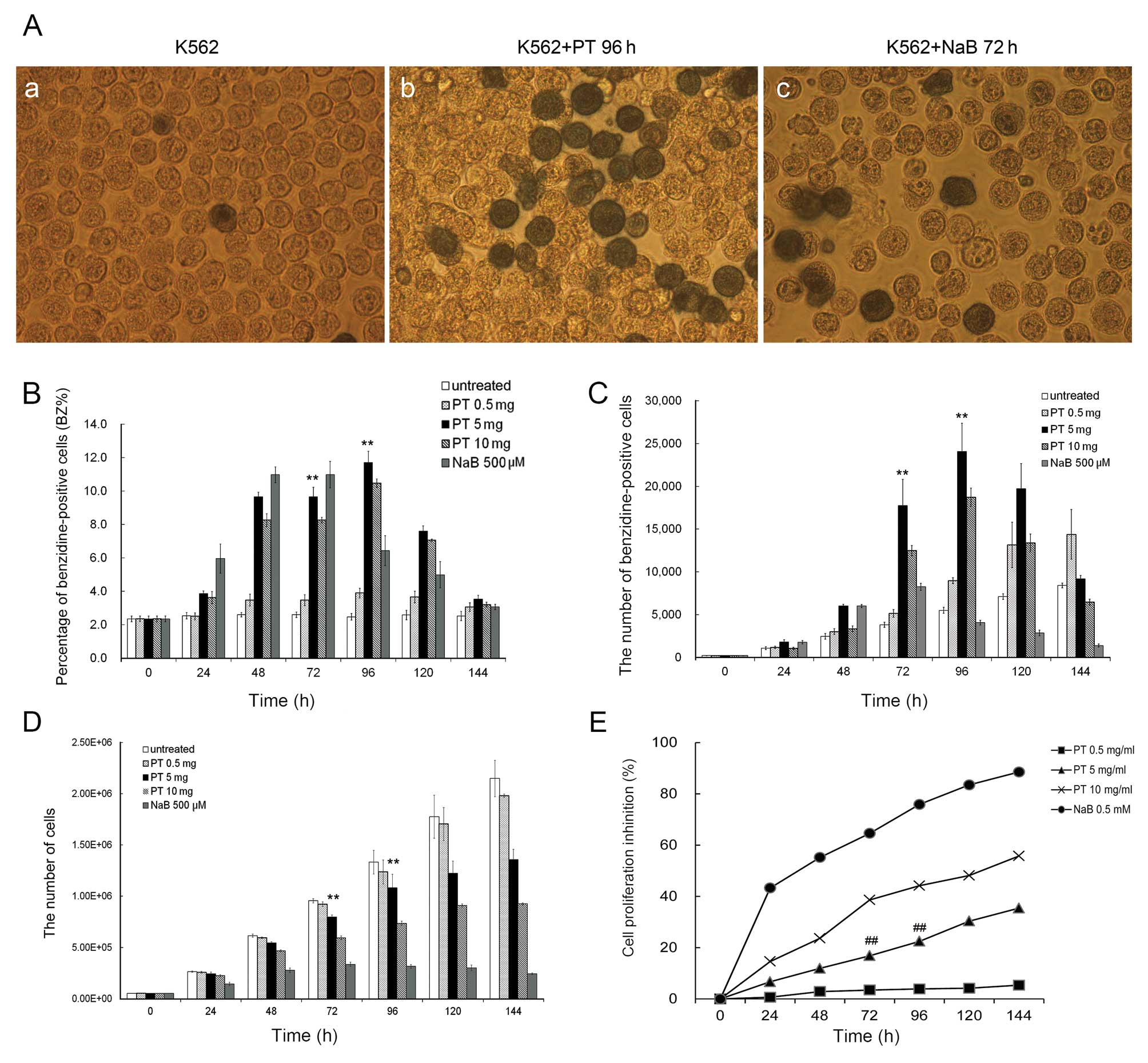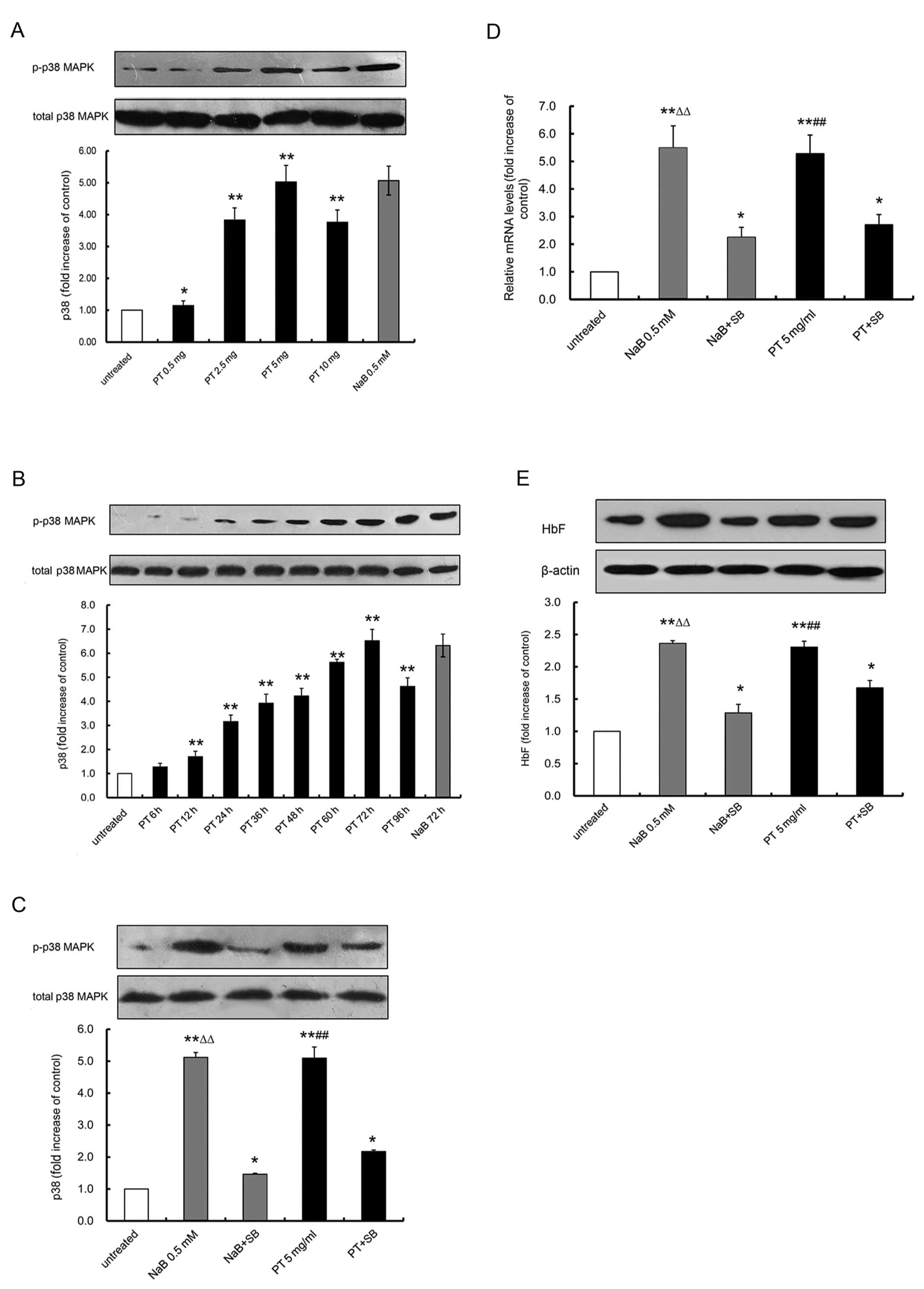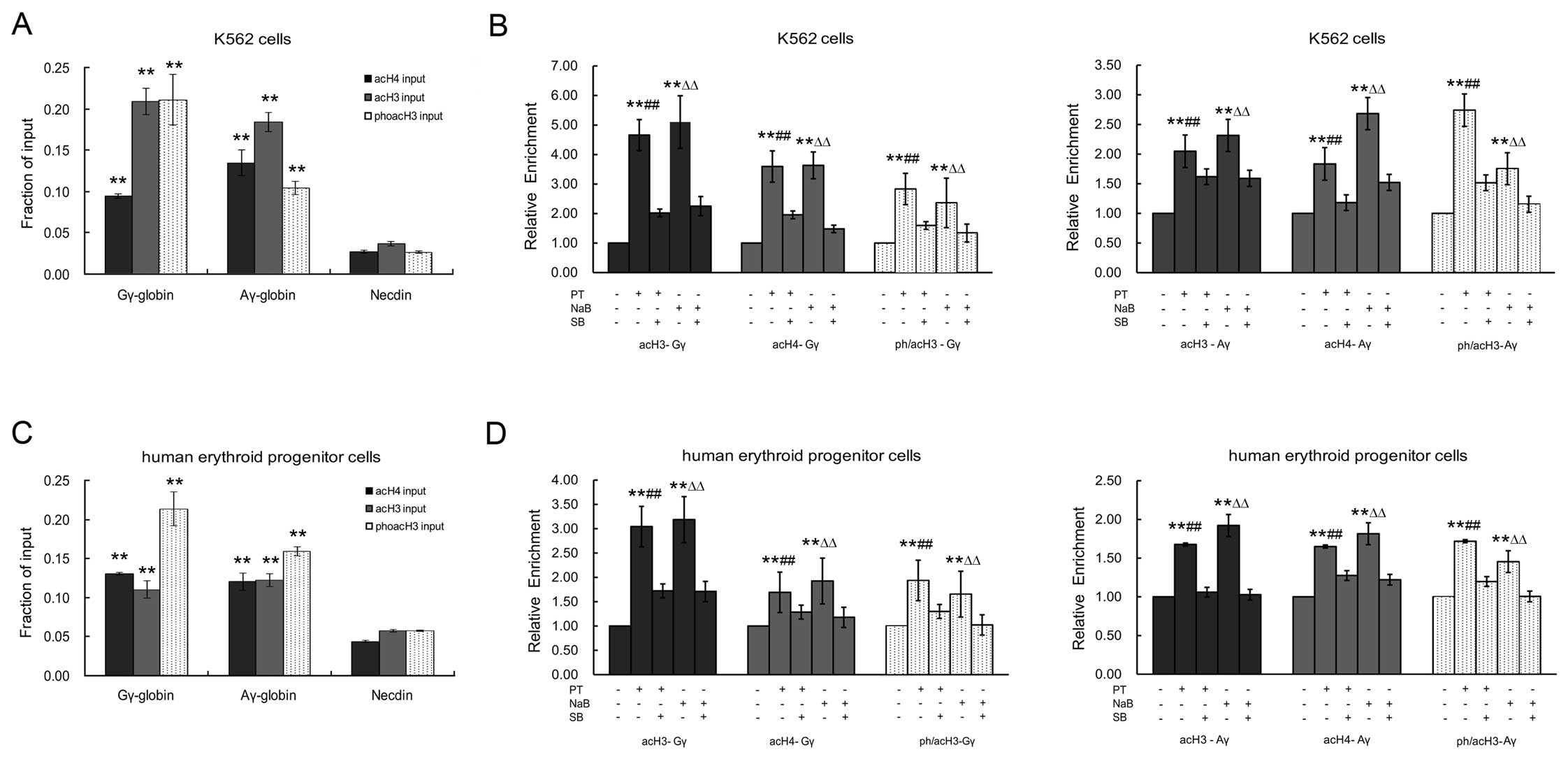|
1
|
Sankaran VG: Targeted therapeutic
strategies for fetal hemoglobin induction. Hematology Am Soc
Hematol Educ Program. 2011:459–465. 2011. View Article : Google Scholar : PubMed/NCBI
|
|
2
|
Higgs DR, Engel JD and Stamatoyannopoulos
G: Thalassaemia. Lancet. 379:373–383. 2012. View Article : Google Scholar : PubMed/NCBI
|
|
3
|
Frenette PS and Atweh GF: Sickle cell
disease: old discoveries, new concepts, and future promise. J Clin
Invest. 117:850–858. 2007. View
Article : Google Scholar : PubMed/NCBI
|
|
4
|
Lawson SE, Roberts IA, Amrolia P, Dokal I,
Szydlo R and Darbyshire PJ: Bone marrow transplantation for
beta-thalassaemia major: the UK experience in two paediatric
centres. Br J Haematol. 120:289–295. 2003. View Article : Google Scholar : PubMed/NCBI
|
|
5
|
Sadelain M, Lisowski L, Samakoglu S,
Rivella S, May C and Riviere I: Progress toward the genetic
treatment of the beta-thalassemias. Ann N Y Acad Sci. 1054:78–91.
2005. View Article : Google Scholar : PubMed/NCBI
|
|
6
|
Sadelain M: Recent advances in globin gene
transfer for the treatment of beta-thalassemia and sickle cell
anemia. Curr Opin Hematol. 13:142–148. 2006. View Article : Google Scholar : PubMed/NCBI
|
|
7
|
Pace BS and Zein S: Understanding
mechanisms of gamma-globin gene regulation to develop strategies
for pharmacological fetal hemoglobin induction. Dev Dyn.
235:1727–1737. 2006. View Article : Google Scholar : PubMed/NCBI
|
|
8
|
Weatherall DJ and Clegg JB: The
Thalassaemia Syndromes. 4th edition. Blackwell Science; Oxford:
2001, View Article : Google Scholar
|
|
9
|
Gambari R and Fibach E: Medicinal
chemistry of fetal hemoglobin inducers for treatment of
beta-thalassemia. Curr Med Chem. 14:199–212. 2007. View Article : Google Scholar : PubMed/NCBI
|
|
10
|
DeSimone J, Koshy M, Dorn L, et al:
Maintenance of elevated fetal hemoglobin levels by decitabine
during dose interval treatment of sickle cell anemia. Blood.
99:3905–3908. 2002. View Article : Google Scholar : PubMed/NCBI
|
|
11
|
Bradai M, Abad MT, Pissard S, Lamraoui F,
Skopinski L and de Montalembert M: Hydroxyurea can eliminate
transfusion requirements in children with severe beta-thalassemia.
Blood. 102:1529–1530. 2003. View Article : Google Scholar : PubMed/NCBI
|
|
12
|
Mankidy R, Faller DV, Mabaera R, et al:
Short-chain fatty acids induce gamma-globin gene expression by
displacement of a HDAC3-NCoR repressor complex. Blood.
108:3179–3186. 2006. View Article : Google Scholar : PubMed/NCBI
|
|
13
|
Johnson J, Hunter R, McElveen R, Qian XH,
Baliga BS and Pace BS: Fetal hemoglobin induction by the histone
deacetylase inhibitor, scriptaid. Cell Mol Biol (Noisy-le-grand).
51:229–238. 2005.PubMed/NCBI
|
|
14
|
Witt O, Monkemeyer S, Ronndahl G, et al:
Induction of fetal hemoglobin expression by the histone deacetylase
inhibitor apicidin. Blood. 101:2001–2007. 2003. View Article : Google Scholar : PubMed/NCBI
|
|
15
|
Perrine SP, Castaneda SA, Boosalis MS,
White GL, Jones BM and Bohacek R: Induction of fetal globin in
beta-thalassemia: Cellular obstacles and molecular progress. Ann N
Y Acad Sci. 1054:257–265. 2005. View Article : Google Scholar : PubMed/NCBI
|
|
16
|
Quek L and Thein SL: Molecular therapies
in beta-thalassaemia. Br J Haematol. 136:353–365. 2007. View Article : Google Scholar : PubMed/NCBI
|
|
17
|
Fathallah H, Sutton M and Atweh GF:
Pharmacological induction of fetal hemoglobin: Why haven’t we been
more successful in thalassemia? Ann N Y Acad Sci. 1054:228–237.
2005.
|
|
18
|
Saunthararajah Y, Lavelle D and DeSimone
J: DNA hypo-methylating agents and sickle cell disease. Br J
Haematol. 126:629–636. 2004. View Article : Google Scholar : PubMed/NCBI
|
|
19
|
Normile D: Asian medicine. The new face of
traditional Chinese medicine. Science. 299:188–190. 2003.
View Article : Google Scholar : PubMed/NCBI
|
|
20
|
Bianchi N, Zuccato C, Lampronti I,
Borgatti M and Gambari R: Fetal hemoglobin inducers from the
natural world: A novel approach for identification of drugs for the
treatment of {beta}-thalassemia and sickle-cell anemia. Evid Based
Complement Alternat Med. 6:141–151. 2009.PubMed/NCBI
|
|
21
|
Fang S, Wu Z, Zhang X, et al: Clinical
observation on YiSuiShengXueGranule on treating 156 patients with
β-thalassemia major and the molecular mechanism study. Biol Pharm
Bull. 30:2084–2087. 2007.PubMed/NCBI
|
|
22
|
Yang M, Qian XH, Zhao DH and Fu SZ:
Effects of Astragalus polysaccharide on the erythroid lineage and
microarray analysis in K562 cells. J Ethnopharmacol. 127:242–250.
2010. View Article : Google Scholar : PubMed/NCBI
|
|
23
|
Guo ZM, Li HJ and Qian XH: γ-globin
synthesis in K562 cells induced with Tortois plastron,
Astragali, Salviae miltiorrhizae and Codonopsis
pilosulae. J Exp Hematology. 16:520–524. 2008.(In Chinese).
|
|
24
|
Miao XY: Shennong Grass after Drainage
(Shen Nong’s Herbal Classic). China Press of Traditional Chinese
Medicine; Beijing: 1997
|
|
25
|
State Pharmacopoeia Commission of the
People’s Republic of China. Carapax et Plastrum Testudinis.
Pharmacopoeia of The People’s Republic China. 1:15–16. 2000.
|
|
26
|
Chen DF, Zeng HP, Du SH, et al: Extracts
from Plastrum testudinis promote proliferation of rat
bone-marrow-derived mesenchymal stem cells. Cell Prolif.
40:196–212. 2007. View Article : Google Scholar : PubMed/NCBI
|
|
27
|
Xie XM, Li XC, Zhong YS, Huang CH and Chen
DF: Study of antioxidant activities of Plastrum Testudinis in
vitro. China Pharmacy. 17:1368–1370. 2006.
|
|
28
|
Chen DF, Li H and Du SH: Effects of
plastrum testudinis on differentiation of transplanted mesenchymal
stem cells into neurons in the injured spinal cord of rat. Chinese
J of Neuroanatomy. 22:233–237. 2006.
|
|
29
|
Fathallah H, Weinberg RS, Galperin Y,
Sutton M and Atweh GF: Role of epigenetic modifications in normal
globin gene regulation and butyrate-mediated induction of fetal
hemoglobin. Blood. 110:3391–3397. 2007. View Article : Google Scholar : PubMed/NCBI
|
|
30
|
Guo ZM, Li HJ and Qian XH: Accumulation of
Gγ-globin mRNA and induction of HbF in K562 cells induced by serum
contained Huangqi. Pharm J Chin PLA. 24:15–19. 2008.
|
|
31
|
Fibach E, Manor D, Oppenheim A and
Rachmilewitz EA: Proliferation and maturation of human erythroid
progenitors in liquid culture. Blood. 73:100–103. 1989.PubMed/NCBI
|
|
32
|
Fibach E: Cell culture and animal models
to screen for promising fetal hemoglobin-stimulating compounds.
Semin Hematol. 38:374–381. 2001. View Article : Google Scholar : PubMed/NCBI
|
|
33
|
Wu QQ, Qian XH and Xu MJ: Effect of
low-dose hydroxyurea with sodium butyrate on globin gene expression
in human erythroid progenitor cells. Nan Fang Yi Ke Da Xue Xue Bao.
29:2073–2076. 20812009.(In Chinese).
|
|
34
|
Lam LT, Ronchini C, Norton J, Capobianco
AJ and Bresnick EH: Suppression of erythroid but not megakaryocytic
differentiation of human K562 erythroleukemic cells by notch-1. J
Biol Chem. 275:19676–19684. 2000. View Article : Google Scholar : PubMed/NCBI
|
|
35
|
Livak KJ and Schmittgen TD: Analysis of
relative gene expression data using real-time quantitative PCR and
the 2(−Delta Delta C(T)) Method. Methods. 25:402–408. 2001.
|
|
36
|
Im H, Grass JA, Johnson KD, Boyer ME, Wu J
and Bresnick EH: Measurement of protein-DNA interactions in vivo by
chromatin immunoprecipitation. Methods Mol Biol. 284:129–146.
2004.PubMed/NCBI
|
|
37
|
Pace BS, Qian XH, Sangerman J, et al: p38
MAP kinase activation mediates gamma-globin gene induction in
erythroid progenitors. Exp Hematol. 31:1089–1096. 2003. View Article : Google Scholar : PubMed/NCBI
|
|
38
|
Mukhopadhyay A, Deplancke B, Walhout AJ
and Tissenbaum HA: Chromatin immunoprecipitation (ChIP) coupled to
detection by quantitative real-time PCR to study transcription
factor binding to DNA in Caenorhabditis elegans. Nat Protoc.
3:698–709. 2008. View Article : Google Scholar : PubMed/NCBI
|
|
39
|
Haring M, Offermann S, Danker T, Horst I,
Peterhansel C and Stam M: Chromatin immunoprecipitation:
optimization, quantitative analysis and data normalization. Plant
Methods. 3:112007. View Article : Google Scholar : PubMed/NCBI
|
|
40
|
Rutherford TR, Clegg JB and Weatherall DJ:
K562 human leukaemic cells synthesise embryonic haemoglobin in
response to haemin. Nature. 280:164–165. 1979. View Article : Google Scholar : PubMed/NCBI
|
|
41
|
Bianchi N, Ongaro F, Chiarabelli C, et al:
Induction of erythroid differentiation of human K562 cells by
cisplatin analogs. Biochem Pharmacol. 60:31–40. 2000. View Article : Google Scholar : PubMed/NCBI
|
|
42
|
Mabaera R, West RJ, Conine SJ, et al: A
cell stress signaling model of fetal hemoglobin induction: what
doesn’t kill red blood cells may make them stronger. Exp Hematol.
36:1057–1072. 2008.PubMed/NCBI
|
|
43
|
Kiefer CM, Hou C, Little JA and Dean A:
Epigenetics of beta-globin gene regulation. Mutat Res. 647:68–76.
2008. View Article : Google Scholar : PubMed/NCBI
|
|
44
|
Thein SL, Menzel S, Lathrop M and Garner
C: Control of fetal hemoglobin: new insights emerging from genomics
and clinical implications. Hum Mol Genet. 18:R216–R223. 2009.
View Article : Google Scholar : PubMed/NCBI
|
|
45
|
Bauer DE and Orkin SH: Update on fetal
hemoglobin gene regulation in hemoglobinopathies. Curr Opin
Pediatr. 23:1–8. 2011. View Article : Google Scholar : PubMed/NCBI
|
|
46
|
Witt O, Sand K and Pekrun A:
Butyrate-induced erythroid differentiation of human K562 leukemia
cells involves inhibition of ERK and activation of p38 MAP kinase
pathways. Blood. 95:2391–2396. 2000.PubMed/NCBI
|
|
47
|
Kouzarides T: Chromatin modifications and
their function. Cell. 128:693–705. 2007. View Article : Google Scholar : PubMed/NCBI
|
|
48
|
Bernstein BE, Meissner A and Lander ES:
The mammalian epigenome. Cell. 128:669–681. 2007. View Article : Google Scholar
|
|
49
|
Turner BM: Defining an epigenetic code.
Nat Cell Biol. 9:2–6. 2007. View Article : Google Scholar
|
|
50
|
Wozniak RJ and Bresnick EH: Epigenetic
control of complex loci during erythropoiesis. Curr Top Dev Biol.
82:55–83. 2008. View Article : Google Scholar : PubMed/NCBI
|
|
51
|
Fathallah H, Portnoy G and Atweh GF:
Epigenetic analysis of the human alpha- and beta-globin gene
clusters. Blood Cells Mol Dis. 40:166–173. 2008. View Article : Google Scholar : PubMed/NCBI
|
|
52
|
Clayton AL and Mahadevan LC: MAP
kinase-mediated phosphoacetylation of histone H3 and inducible gene
regulation. FEBS Lett. 546:51–58. 2003. View Article : Google Scholar : PubMed/NCBI
|














